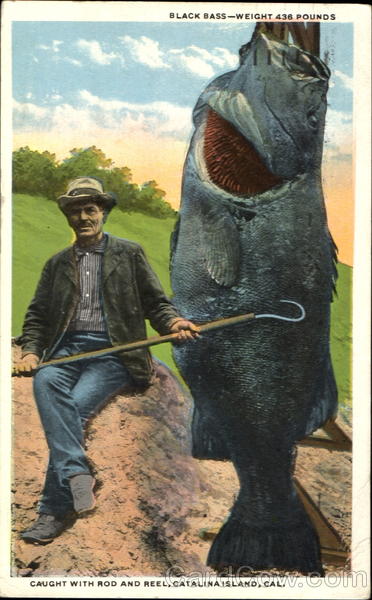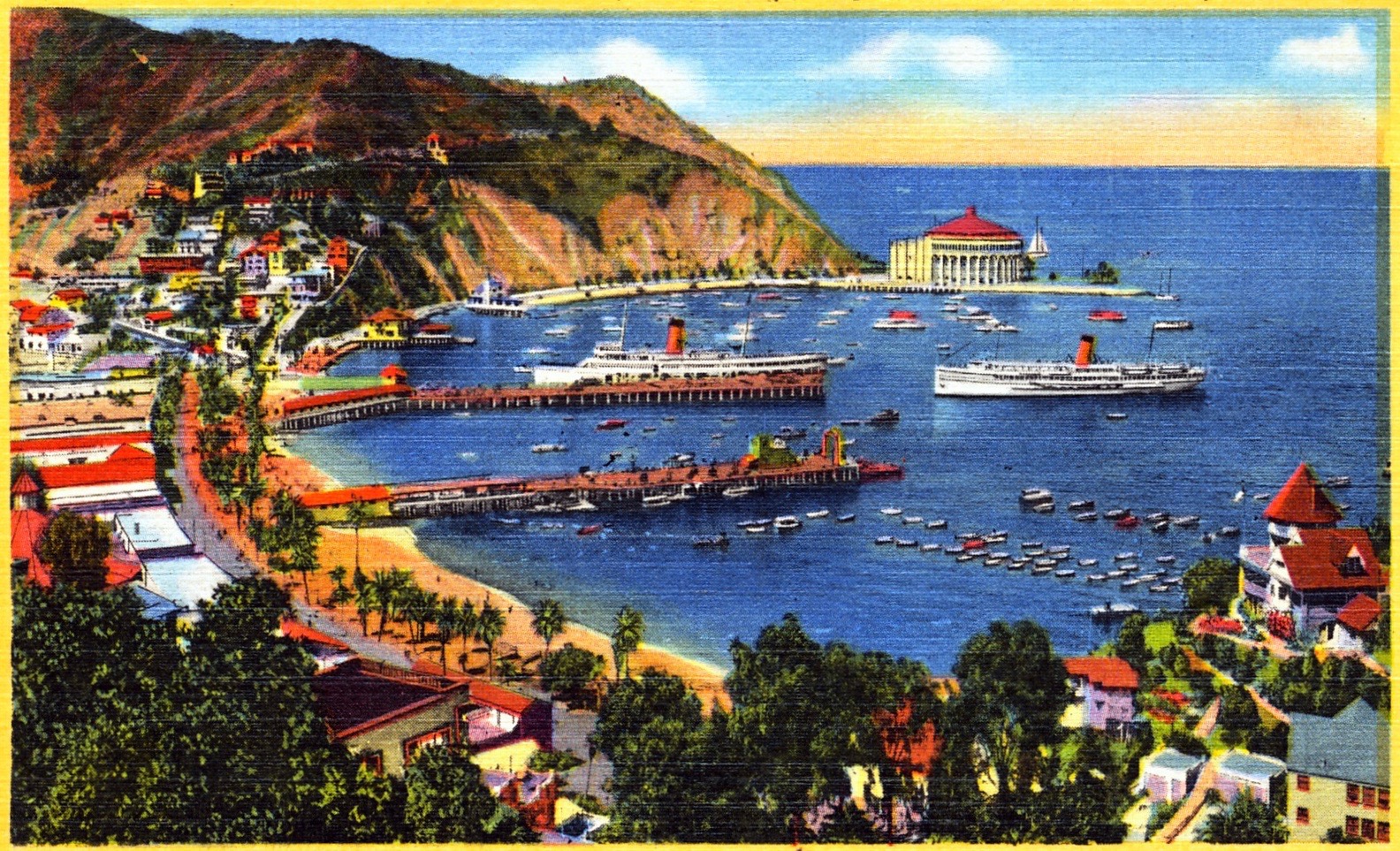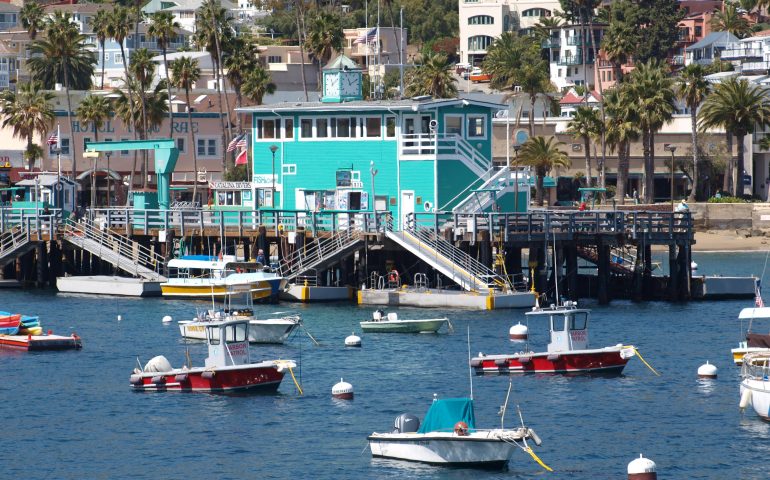—Los Angeles Times, June 26, 1910
Little Miss Margery Powell, aged ten years, daughter of Captain H. M. Powell, U.S.A., who is commandant of the State University of Arizona, has set the fashion for small girls at Avalon by fishing assiduously off the wharf. This small girl, who had never had a rod in her hand before, has landed fifty-six fish. Early in the morning she starts out and no childish amusement can draw her attention from her fascinating occupation. She is a true little sportswoman, and her father’s own daughter in the enjoyment of fishing and hunting.
—Los Angeles Times, September 14, 1910
Gold Button Yellowtail
Avalon, April 3.—While fishing within several feet from the wharf last evening, Col. N. F. Stearns of Los Angeles brought to gaff a yellowtail weighing forty-four and one-fourth pounds. The fish is the largest catch taken here this season and is the first gold button yellowtail which has been caught for several months. Col. Stearns is second vice-president of the Catalina Tuna Club.
—Los Angeles Times, April 4, 1911
The City of Avalon took over the Avalon Pleasure Pier from the Board of Freeholders… Four white sea bass were caught by angler A. E. Eaton Sunday night. The heaviest weighed 40 lbs.
—Catalina Islander, July 4, 1916
“Today I actually saw swordfish, tuna, albacore, yellowtail, barracuda, mackerel, sardines, smelt and rock bass right from the Avalon pleasure pier. The bay was alive with churning, slashing, feeding yellowtail, barracuda and tuna all day, and the great schools of sardines, smelt and Spanish mackerel were furnishing wonderful sport and a big feed for the larger cannibalistic members of the sea family.”—Avalon Islander.
—Oakland Tribune, December 19, 1917
A grouper shark weighing 285 pounds was caught off the Avalon Pleasure Pier by Captain John Kassar. He had to call for help to land the fish.
— Catalina Islander, December 10, 1918

Editor Catalina Islander,
In response to your request for a true story of the first or largest fish I ever caught in Catalina waters, the following is my effort:
… Coming into the bay, and near the pier, I let my line drop over the side just for the fun of the thing, and it trailed a short distance behind the boat. And then came a strike, which developed into a decisive run, and on reeling in—a ten pound barracuda. Hastily throwing in our lines again, we caught in quick succession five big barracuda, seven big mackerel, and four white sea bass; all in the bay close to the pier. And the next morning I went out on the small pier which juts out from the hotel grounds and dropped a hand line from the end and caught a nine-pound bass.
I can only say, in conclusion, many may go further and fare worse. Best wishes, Alfred Reeves
—Catalina Islander, December 10, 1924
Shark Stories Held Fictions — Man-Eating Variety Absent From Local Waters — Recent Report of Experts is Basis of Statement — Attacks on Swimmers Purely Munchausen Tales
Fishermen merely laugh, but experts and Southland boosters scowl at reports of man-eating sharks and guns to keep them away from the recent Catalina Island swimmers. Because, there are no man-eating sharks or any other ferocious fish in these waters!
At least three of the greatest authorities on California fish say as much. They are Dr. David Starr Jordan, Dr. Barton W. Evermann, curator for the Academy of Sciences at Golden Gate Park, and Dr. Charles F. Gilbert, recently retired from Leland Stanford University. They recently completed the classification and identification of all game and commercial fish in California waters, after investigations covering years.
Such authority is cited by Roy Beaton, secretary of the San Pedro Chamber of Commerce to counteract stories deemed damaging and untrue that swimmers of the Catalina channel are being terrified by the monsters, and guns from escorting boats have been brought into play.
Half a dozen species of sharks thrive here, but of such harmless kinds as the blue, bonito, shovelnose, leopard, dog and hammerhead, according to H. B. Nidever, in charge of Terminal Island laboratories for the California Fish and Game Commission.
Police and hospital records also fail to disclose a single victim ever attacked by anything but stingrays and little octopi, now retreating from the beaches before the advancing hordes of bathers.
Southern Californians are not fooled by such canards, according to Beaton, but the fabrications about man-eating sharks is bad California doctrine for the rest of the world that some day hopes to frolic in the Southland’s waves.
—Los Angeles Times, September 11, 1926
CATALINA FISHING—A few days ago a large school of bait came in close to shore near the pleasure pier and the bath house; some were driven ashore by small barracuda, of which there are a number from 6 to 10 inches long around now. They are fish that hatched out this past summer.
—Capt. Earl A. Wood, Catalina Islander, December 7, 1932
The past week has been a great one for catching white sea bass. The best run since 1929 is on now. They are seen around all the piers, the quarry pier, Toyon Camp pier, at the Isthmus, St. Catherine pier, Casino pier—even around the pleasure pier.
—Capt. Earl A. Wood, Catalina Islander, July 5, 1933
Catalina Fishing—The boys have been having a lot of fun trying to land some of the big yellowtail from the Pleasure Pier. They are around daily. Plenty of little green-back mackerel every morning for the pier fishermen.
—Capt. Earl A. Wood, Catalina Islander, October 25, 1934
Catalina Fishing—Most all summer there has been a small school of three yellowtail around the Pleasure Pier daily. One of the big fellows might be the fish caught by C. R. Martin of Avalon, a light tackle fish of 25 ¼ lbs. That is a catch hard to beat.
—Capt. Earl A. Wood, Catalina Islander, August 8, 1935
Catalina Fishing—The past week finds fishing getting better daily. The yellowtail are being brought in, and now barracuda are arriving to feed. Quite a number are in the catches.
I saw one yellowtail caught from the end of the Pleasure Pier this morning. They have kept a marvelous school of sardines, Spanish mackerel and green back mackerel herded in the bay. They seem to be as thick as you would see the bait in the live bait tank at times. They are last year’s hatch, and are 5 to 8 inches in length. They feed but very little, so they are hard to catch, except the green back mackerel. Boys on the Pleasure Pier and from boats have a lot of fun catching them…
Tuesday evening, May 5, Pat Casey, better known as “Barracuda Jim”, caught and landed the first white sea bass of the season—a beauty of 45 lbs. Time, 15 minutes. He was fishing from the end of the Pleasure Pier when he got the strike. It was dark, but the way the fish ran he knew he had a fine catch. He caught it on a number 15 line. There are quite a few seen along the coast.
—Capt. Earl A. Wood, Catalina Islander, May 14, 1936
Catalina Fishing—The Pleasure Pier is a very interesting place evenings now, as so many are going out after swordfish. Many anglers are getting fish hooked and lost. Many are also being caught these days. Mornings and evenings boys and girls are seen on the pier fishing for the little greenback mackerel. Some rock bass are also being caught. There is a lot of bait in the bay now, as almost every morning the larger fish outside chase the bait in near the pier. The sardines and little mackerel are growing fast. They are this year’s hatch, and each day sees them a little larger in size. The sardines are big enough to be good bait for rock bass.
—Capt. Earl A. Wood, Catalina Islander, August 13, 1936

History of Avalon and the Green Pleasure Pier. The “Magic Isle,” the “Enchanted Isle,” the “Island of Romance,” “Fantasy Island,” or “Beautiful Isle Of The Pacific”— all are simply names bestowed upon one of my favorite places to visit—Santa Catalina Island.
As deserving the names, it’s also an island rich in history with some good times and some hard times, some good events and maybe a few that weren’t so good. But it’s also a fascinating history one that was rarely boring.
Although Catalina had once been populated by the Gabrielino/Tongva tribe, who called the island Pimu or Pimugna, all had died or moved to the mainland by the mid-1800s.
In 1602, the island was rediscovered by Spanish explorer, Viscaino, who landed here on Saint Catherine’s Feast Day (St. Catherine of Alexandria). He named it Santa Catalina Island in her honor.
A German immigrant, Augustus William Timms began to run a sheep herding business on the island in the 1860s. He would bring people over to the island on his boat, the Rosita, for bathing and fishing and the small settlement soon was called Timms Landing by most (although some used the name Dakin’s Cove up until the eventual sale of the island). By 1883 Timms Landing had three buildings and thirty tents.
In any historical sketch of the seaside resorts around the city of Los Angeles, mention of Catalina, the Magic Isle, could hardly be omitted.
While Santa Monica and other beaches on the mainland were easily accessible in the pioneer days, the trip to Catalina was rather a serious matter. There was no daily steamer plying between San Pedro and the island in those early days, nor was there any regular means of communication between the island and the mainland. But the magical attractions of the island were well understood by the scant population of Southern California in those pioneer days.
The way of enjoying the pleasures of island life at that time was to form a party more or less numerous, anywhere from half a dozen to a score. These provided themselves with tents in families or in little cliques of bachelors or bachelor maids, the latter, of course, under a chaperone. These were taken to San Pedro by stage, and from the embarcadero over to the island in a big sailboat or yawl hired for the occasion.
These campers would find a good deal of difficulty in returning to the mainland for provisions, and so a complete outfit was generally taken of canned goods and other non-perishable foods to last for ten days or two weeks, while the party was to remain on the island. California cook stoves and other camp paraphernalia were prominent features in these outfits for camping upon the island.
Of course, there were small boats there, which could be hired to row and fish. There were more wild goats on Catalina at that time than at present, and there were no restrictions about either shooting or fishing.
There was no more ideal camp life in the world than that enjoyed by the few adventurous spirits among the pioneers, who, spurning accessible Santa Monica, crossed the twenty-mile channel, cut themselves off from the world for two or three weeks and lived upon camp rations during the whole of their stay on the island.
The sea easily furnished one-half of the food of the encampment, and it would be hard to conjure up in one’s mind a more tempting and delicious breakfast than that of fish, fresh caught from the salt water, and broiled upon the coals an hour after they came out of the sea.
It is about twenty years since the Banning brothers bought the island from the Lick estate and established means of easy communication between the mainland and the island. Since then Avalon, with its fine hotels and other features of town life, has grown up upon the beautiful bay. But the features of life upon Catalina at the present time do not come within the scope of historical reference.
—A Backward Glance Down The Surf Line,, Los Angeles Times, July 8, 1906
In 1887, real estate speculator George R. Shatto bought Catalina Island for $200,000 from the estate of James Lick. Shatto developed the town site (including laying out streets) and his sister, Etta M. Whitney, gave it the name of Avalon, apparently naming it after a mythical island valley in the Tennyson poem Idylls of the King, the paradise where King Arthur’s Knights of the Round Table went to heal their wounds. A 1903 edition of Webster’s Dictionary gives the meaning of Avalon as “Beautiful Isle of the Blest,” and “Bright Gem of the Ocean,” so perhaps she was right.

[…] the bike tour we walked around Green Pleasure Pier while we waited for our Jeep tour. We had about an hour to kill so we window shopped. You will not […]